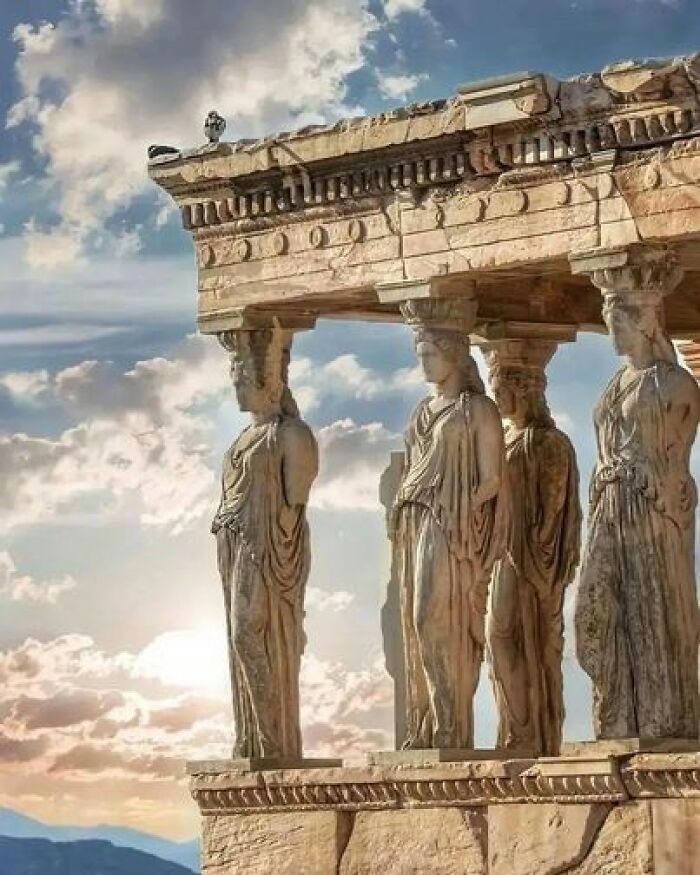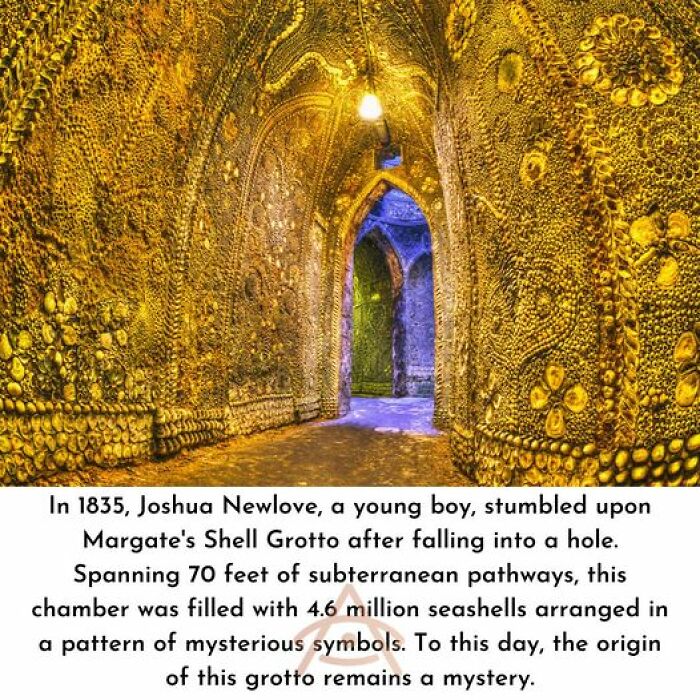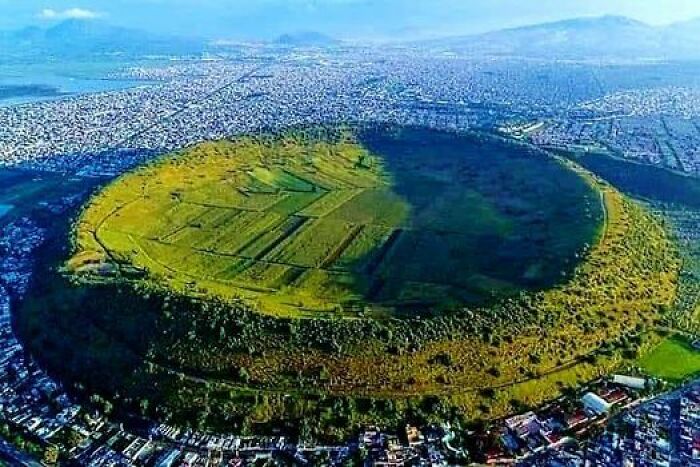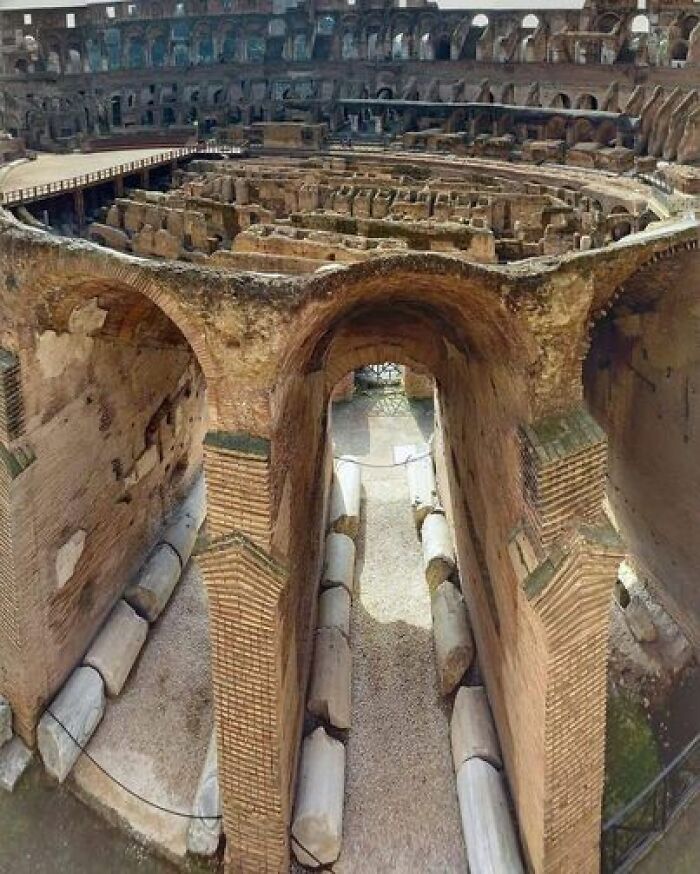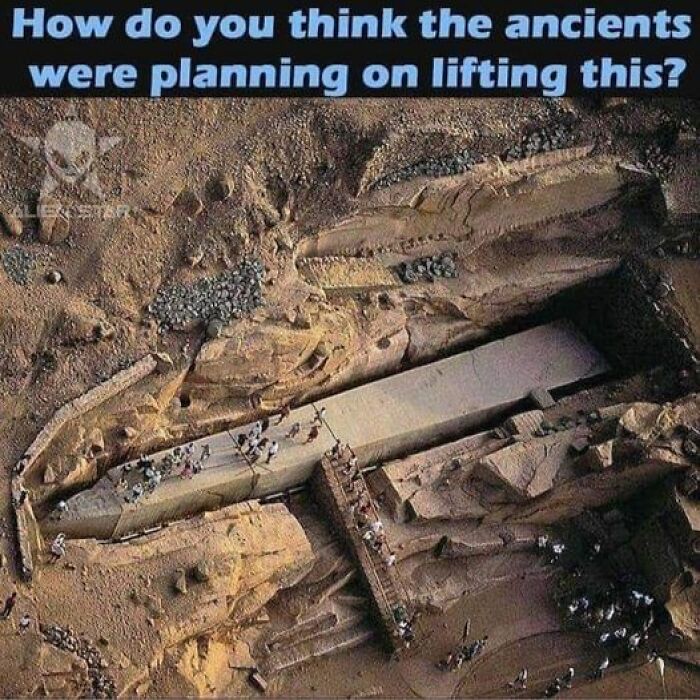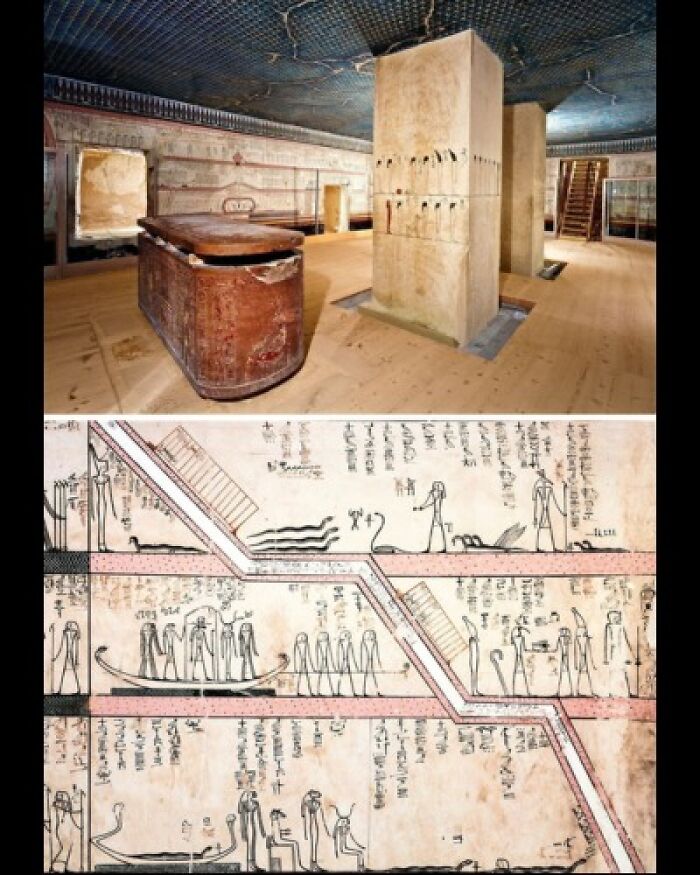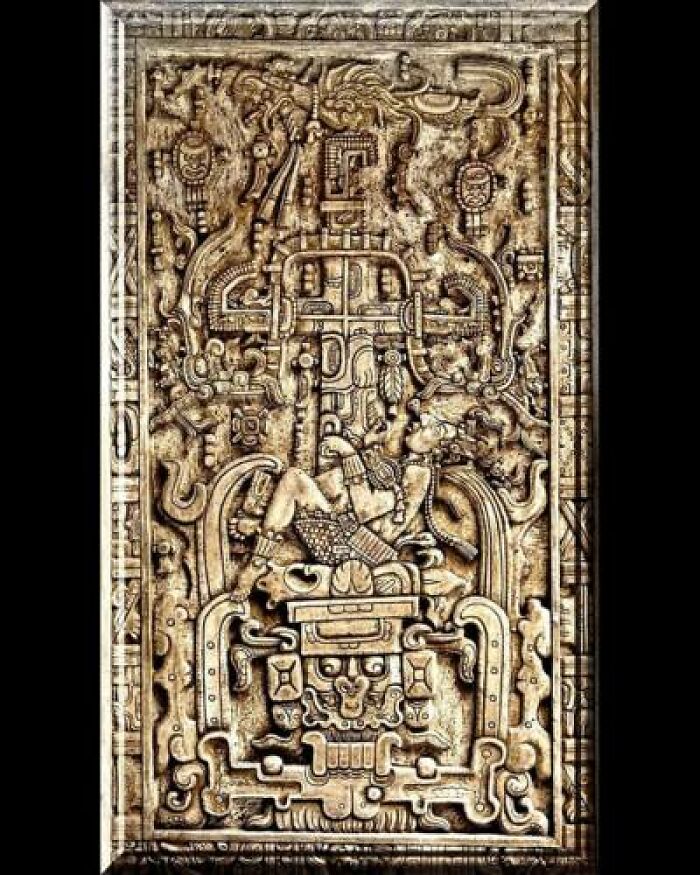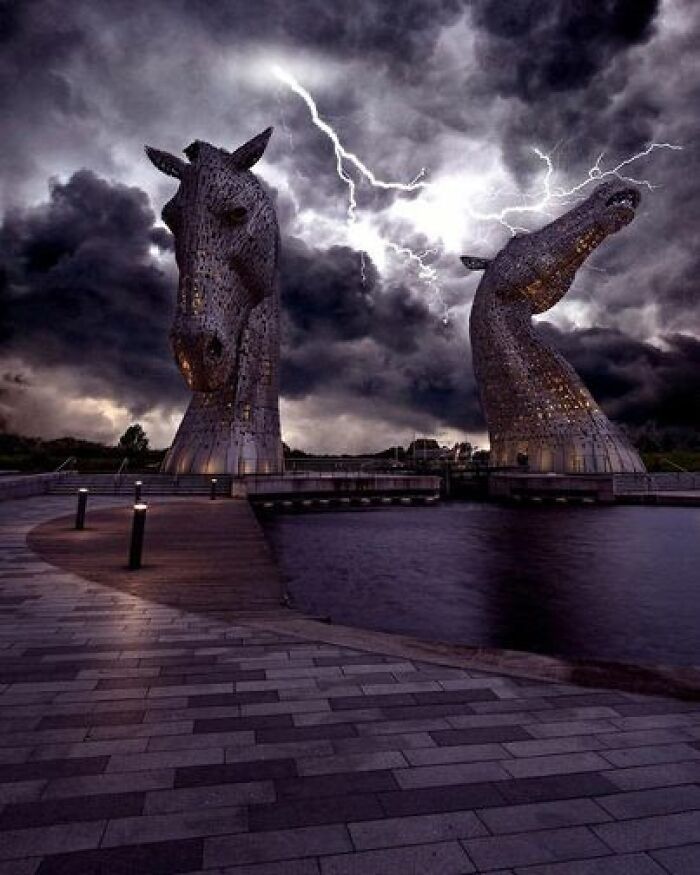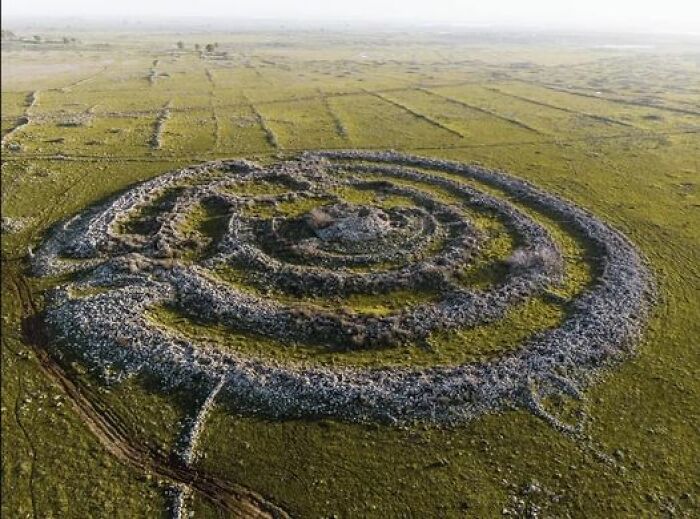The subject of history is a bottomless pit of interesting facts. The deeper you delve into it, the more information there seems to be waiting to be unveiled, which is part of what makes it fascinating. And with seemingly no end in sight, browsing history-related facts can be even more enthralling.
If you ever find yourself spellbound by events of the past or historical sites, we have quite a treat for you today. Below you will find a list of history-related posts, as shared by the ‘Ancient Explorers’ Facebook page, covering everything from ancient buildings to feats of engineering, mosaics, and much more. Wait no longer, scroll down to browse it, and familiarize yourself with some more interesting information from the seemingly inexhaustible world of history.
Below you will also find thoughts shared by associate professor of history at Southern Utah University, Dave Lunt, who was kind enough to answer a few of Bored Panda’s questions.
This post may include affiliate links.
In The Mid-9th Century, Norse Settlers Established Their Presence In The Faroe Islands, Although Some Evidence Hints At Earlier Settlement. Among The Island's Notable Features Is Sørvágsvatn, One Of Its Largest Lakes, Which Astonishingly Rests Approximately 130 Feet (40 Meters) Above Sea Level, Offering A Breathtaking Sight
It sounds like this was really common. Those sick puppies!
The Erechtheion, An Ancient Greek Temple, Was Built On The Acropolis Of Athens During The Golden Age Of The City, Between 421 And 406 Bce. Its Primary Purpose Was To Serve As A Sanctuary For The Ancient Wooden Cult Statue Of Athena, While Also Serving As A Grand Tribute To The Greatness Of Athens During Its Peak Of Power And Influence. Despite Enduring A Tumultuous History Of Misuse And Neglect, The Erechtheion Has Persisted As A Prominent And Remarkable Structure From Antiquity. Its Elevated Location Above The City, Coupled With The Striking Porch Featuring Six Caryatids, Contributes To Its Enduring Distinction And Allure
“I often hear something along the lines of needing to learn history so that we don’t repeat it, but I don’t really like that saying,” Dave Lunt told Bored Panda when discussing the importance of familiarizing yourself with history. “There are things in history that I think would be really cool to repeat (more lessons from Socrates, please!), and—of course—more seriously, people aren’t robots, societies aren’t machines; history can’t repeat, since circumstances are always changing.
“An ancient Greek philosopher named Heraclitus said that nobody can step into the same river twice, since the waters are always changing. Aristotle criticized history because it related what was ‘true’ just one time, while poetry was able to convey universal and unchanging ‘truth’.”
Amidst The Ongoing Debates, We're Curious To Hear Your Thoughts On This Matter
Incredible discovery: Egyptians and Maya had eyesight and were able to look up!
Visualize This Singular Stone Amidst A Staggering Assemblage Of Over 2.3 Million Stones Meticulously Cut, Painstakingly Transported, And Masterfully Positioned To Construct The Awe-Inspiring Great Pyramid Over Three Millennia Ago
So why should we learn history, you might wonder? Well, Prof. Lunt suggested there are a lot of reasons, expanding on a few: “One reason is that it makes us empathetic. To learn what other people have done, suffered, enjoyed, accomplished, experienced helps us to imagine ourselves outside of our own worlds.
“Another reason to study history is that it makes us better citizens (at least, that’s the goal). Learning about a nation’s past helps voting citizens make informed decisions.”
Nestled Within The Ancient Ruins Of Persepolis, Shiraz, Iran, Stands The Iconic Welcoming Gate Of All Nations, Also Recognized As The Gate Of Xerxes. This Architectural Marvel Serves As A Vivid Connection To The Past And The Grandeur Of Persian History. The Roots Of Persepolis Trace Back To The Visionary Efforts Of Darius The Great, A Notable Figure Reigning From 522 To 486 Bc. After Successfully Reinstating 23 States Across The Middle East, Darius Undertook The Ambitious Task Of Erecting Persepolis. This City, A Testament To His Leadership And The Resilience Of The Empire, Would Eventually Become A Beacon Of Cultural Exchange And Diplomacy. Xerxes, The Son Of Darius, Further Enriched Persepolis' Splendor By Overseeing Its Completion In 465 Bc. The Welcoming Gate Of All Nations, Aptly Named, Embodies The Essence Of Unity Amidst Diversity. Its Intricate Carvings And Distinctive Symbols Represent The Various Nations Under Persian Influence, Underscoring The Empire's Commitment To Peaceful Coexistence. As We Admire The Gate Of All Nations, We're Transported Back To An Era When Architecture Was A Testament To Diplomacy And The Rich Heritage Of Persia. It Stands Not Only As A Physical Structure But As A Bridge To The Stories Of Those Who Once Passed Through Its Gates, A Tribute To The Vision Of Leaders Who Shaped History
The Persian Qanat, Also Known As Qanats, Represent An Astonishing Feat Of Engineering That Dates Back 3,000 Years. These Remarkable Systems Are Found In Desert Regions Of Iran And Continue To Be Utilized Today. Originating During The Iron Age, The Process Of Constructing Qanats Involved Skilled Surveyors Identifying Elevated Water Sources, Often Located At The Head Of Former River Valleys Or Even Within Cave Lakes. Subsequently, They Meticulously Carved Lengthy, Sloping Tunnels From These Water Sources To The Areas Where Water Was Needed. The Visible Openings Seen Above Ground Are Carefully Crafted Air Shafts, Designed To Release Dust And Provide Much-Needed Oxygen For The Workers Who Tirelessly Dug The Qanats By Hand, Sometimes Spanning Distances Of Up To Forty Miles. Eventually, These Tunnels Emerge At Ground Level, Transforming Into Captivating Oases. The Construction Of Qanats Demanded Painstaking Effort, Requiring Immense Precision. The Slope Of The Tunnels Had To Be Precisely Calculated To Allow Water To Flow Freely Without Stagnation. If The Slope Was Too Steep, The Force Of The Water Could Accelerate Erosion And Cause Tunnel Collapse. Even After Completion, Qanats Necessitate Annual Maintenance. However, The Irrigation Tunnels Played A Crucial Role In Enabling Agriculture To Thrive In The Arid Desert Regions. This Innovative Technology Gradually Spread Through Trade Along The Silk Road And The Expansion Of Muslim Conquests. As A Result, Qanats Can Be Found As Far Away As Morocco And Spain. The Persian Qanats Are A Testament To The Ingenuity And Enduring Legacy Of Ancient Engineering, Creating Fertile Landscapes In Inhospitable Terrains And Providing A Valuable Water Supply That Has Sustained Communities For Centuries
“Finally (for me), history is really, really interesting,” the historian shared. “People are complicated; they don’t always make rational decisions. Crazy things happen. Luck, circumstance, and decisions change all of the time. Drama is drama, and human drama is very, very compelling.
“On the one hand, I sense a great continuity with people who came before us. People really do have some things in common over time and distance. On the other hand, the people of the past are so very different from the people of today that ‘understanding’ them completely is really out of the question,” Lunt expanded.
The Mysterious Walls Of Sacsayhuaman Among Them, The Most Intriguing Are The Three Zig-Zag Walls That Serve As Protective Fortifications For The Ancient Citadel. These Walls Were Constructed Using Stones That Appear To Be Impossible To Move Without The Aid Of Heavy Machinery. To Put It Into Perspective, The Weight Of Certain Rocks Surpasses A Hundred Tons, While A Medium-Sized Car Weighs Less Than Two Tons. Moreover, It Is Worth Noting That The Tallest Rock Stands At An Impressive Height Of 9 Meters. Beyond Their Sheer Weight, These Rocks In Sacsayhuaman Are Fitted Together With A Precision That Surpasses The Capabilities Of Hand Tools Known To Us Today. When The Spanish Colonizers Arrived In The Area, They Dismantled Numerous Inca And Killike Structures To Repurpose The Materials For Their Own Buildings. However, When Confronted With The Walls Of Sacsayhuaman, They Were Unable To Move The Colossal Rocks. Consequently, The Spanish Attributed The Construction Of These Walls To Supernatural Forces, Owing To Their Immense Size. Is It Conceivable That The Ancient Civilizations Residing In Sacsayhuaman Possessed Knowledge And Techniques That Elude Our Current Understanding? At Present, We Cannot Definitively Answer This Question. What We Do Know Is That These Walls Have Withstood The Test Of Time, Remaining Resilient Against Natural Disasters And All Attempts At Demolition Up To The Present Day
The Shell Grotto Is An Ornate Subterranean Passageway Shell Grotto In Margate, Kent, England. Almost All The Surface Area Of The Walls And Roof Is Covered In Mosaics Created Entirely Of Seashells, Totalling About 2,000 Square Feet Of Mosaic, Or 4.6 Million Shells
Weird. When I did the extensive research of reading the wikipedia page I discovered the grotto was "discovered" by an excavation done by adults and then immediately became a privately owned tourist site.
The Xico Volcanic Crater, Also Referred To As Cerro De Xico Or The "Hill Of Xico," Boasts A One-Kilometer-Wide Expanse That Offers A Unique Sanctuary Of Fertile Soil And Naturally Shielded Farmland Amidst The Continuous Expansion Of Mexico City. Centuries Ago, This Area, Including The Xico Crater And Its Surroundings, Was Submerged Beneath The Waters Of Lake Chalco. However, During The 16th Or 17th Century, The Lake Underwent Drainage Efforts To Create Agricultural And Developmental Opportunities For The Region. Today, The Xico Volcanic Crater Stands As A Testament To The Transformative Nature Of Human Ingenuity And Serves As A Haven Of Productivity And Natural Beauty Amid The Urban Landscape
I can't even read this. I can only think about how unnatural it is to type every word in a sentence with a capital letter.
The expert suggested that social media accounts, such as ‘Ancient Explorers’, can come in handy not only for the users but for researchers in the future as well. “I believe that [social media] is an important way that people communicate today; so, it’s going to be an important source for future historians when they try to make sense of the 21st-century world,” he told Bored Panda.
“Also, I think that there’s ‘something for everyone’ in the history buffet, and if social media can pique and stoke people’s curiosity and interests, then that’s great news,” the expert added, noting that there are different kinds of ‘history’ out there, such as social, economic, political, and gender, to name a few.
“Of course, social media can amplify inaccurate facts and events, or questionable interpretations of them. This is another good reason for people to practice historical thinking—so that they can assess their sources and critically evaluate the information before deciding which interpretation(s) they find most compelling.”
How Was It Possible To Construct Such A Marvel Without Knowledge Of Geometry, Mathematics, Physics, Engineering, And Other Sciences? Yet, Our Ancestors Had Access To All Of These And More. The Chand Baori, A Hidden Treasure Of Bharat, Was Constructed Over 1000 Years Ago In The Abhaneri Village Of Rajasthan, India. This Extraordinary Well Is An Architectural Wonder, With A Depth Of 64 Feet, 13 Floors, And 3,500 Narrow Steps Arranged In Impeccable Symmetry. It Is One Of The World's Largest And Most Stunning Stepwells, Showcasing The Remarkable Abilities Of Our Ancestors
In Ancient Times, The Civilization Of Egypt Faced A Series Of Unexplained Assaults By A Formidable Fleet Of Imposing Warships. These Enigmatic Aggressors Emerged Unexpectedly Around 1250 Bce And Persistently Launched Attacks Until Their Eventual Defeat At The Hands Of Ramesses III. Intriguingly, No Historical Accounts Or Evidence Of Their Existence Can Be Found Beyond 1178 Bce, Leaving Scholars To Engage In Ongoing Debates And Formulate Various Theories Regarding Their Origins, Destination, And Identity. Due To The Lack Of Concrete Information, They Have Come To Be Known Simply As The Sea Peoples. The Mystery Surrounding The Sea Peoples Continues To Captivate The Imagination Of Researchers And Historians, As They Endeavor To Unravel The Secrets Of This Ancient Maritime Threat
Ely Cathedral In Ely, England, Boasts An Awe-Inspiring Masterpiece Of Craftsmanship And Artistic Brilliance In Its Soaring Ceiling. 🏰🌟 The Cathedral's Roof Is Adorned With Intricate Medieval Woodwork, Featuring Exquisitely Carved Beams And Vaulted Ceilings That Create A Mesmerizing Visual Spectacle. As You Step Inside, Your Eyes Are Immediately Drawn Upward, Captivated By The Grandeur And Beauty Of This Architectural Wonder. The Intricate Detailing And Skilled Artistry Showcased In The Ceiling Transport You Back In Time, Evoking A Sense Of Wonder And Reverence For The Craftsmanship Of The Past. Ely Cathedral Stands As A Testament To The Ingenuity And Dedication Of Those Who Built It, Leaving Visitors In Awe Of Its Timeless Magnificence
The Aqueduct At Machu Picchu, Dating Back To 1200 Bc, Stands As One Of The Remarkable Examples Of Functional Ancient Hydraulic Systems In The Americas, With Three Such Structures That Continue To Operate To This Day
Then And Now: The Temple Of Abu Simbel, Egypt. During His Reign, Ramesses II Initiated An Expansive Construction Campaign Across Egypt And Its Controlled Territory Of Nubia. Nubia Held Significant Importance For The Egyptians Due To Its Abundant Gold Reserves And Valuable Trade Commodities. Consequently, Ramesses II Erected Numerous Magnificent Temples In Nubia, Aiming To Showcase Egypt's Power And Influence While Also Influencing The Nubian People To Adopt An Egyptian Way Of Life. Among These Notable Temples Are The Rock-Cut Structures Situated Near The Modern Village Of Abu Simbel, Located At The Second Nile Cataract, Marking The Boundary Between Lower Nubia And Upper Nubia. Two Remarkable Temples Were Built—the Great Temple, Devoted To Ramesses II Himself, And The Small Temple, Dedicated To His Esteemed Chief Wife, Queen Nefertari
In The Southern Province Of Adana's Yumurtalık District In Modern-Day Turkey, An Extraordinary Mosaic Has Been Discovered. This Mosaic Showcases An Eros Figure, A Character From Greek Mythology, Depicted As Fishing While Riding A Horse. Interestingly, This Particular Portrayal Of Eros Is Unique, As It Combines The Features Of Both A Fish And A Horse, Making It Reminiscent Of The Mythical Creature Known As Hippocampus In Greek Mythology. As A Result, It Is Believed That This Mosaic Is The Only One Of Its Kind In The Entire World, Adding To Its Significance And Fascination For Archaeologists And Enthusiasts Alike
Tijuca Peak, Also Known As Pico Da Tijuca, Is A Majestic Mountain Located Within The City Of Rio De Janeiro, Brazil. It Stands As The Most Prominent Peak In The Urban Area Of Rio De Janeiro City, Offering Breathtaking Views Of The Surrounding Landscape. This Awe-Inspiring Mountain Is An Integral Part Of The Tijuca National Park, A Protected Area Spanning An Impressive 3,958.41 Hectares (9,781.4 Acres) And Designated As Such In 1961 To Preserve Its Natural Beauty And Ecological Significance. To Ascend To The Summit Of Pico Da Tijuca, There Are Well-Constructed Stairs Carefully Cut Into The Rock. These Stairs Serve As A Means For Both Locals And Visitors To Experience The Thrill Of Conquering The Peak And Revel In The Panoramic Vistas It Offers. The Hike Up The Mountain Not Only Rewards Adventurers With Stunning Scenery But Also Allows Them To Immerse Themselves In The Lush Tropical Forest Of The Tijuca National Park, Which Boasts A Rich Diversity Of Flora And Fauna. Tijuca Peak Holds A Special Place In The Hearts Of Rio De Janeiro's Residents And Attracts Tourists From Around The World Who Seek Both Outdoor Adventure And A Deep Connection With Nature. The Presence Of This Magnificent Mountain Within The City's Urban Landscape Highlights The Unique Juxtaposition Of Natural Wonders And Modern Urban Life That Rio De Janeiro Offers. As A Cherished Part Of The Tijuca National Park, Pico Da Tijuca Continues To Be A Symbol Of Environmental Conservation And An Inviting Destination For All Those Who Wish To Explore The Beauty Of This Dynamic Brazilian Metropolis
The Oldest Bridges On Earth Today
Greek here!Its actually the oldest bridge in Europe,to be fair.We have it here,dont know where exactly.
The Enigmatic "Gate Of The Gods" At Aramu Muru! 🚪✨ Nestled Near Lake Titicaca In Peru, This Abandoned Stone Carving Has Captivated The Imagination Of Explorers Since Its Discovery In The Early 1990s. Believed To Be An Unfinished Project By The Ancient Incans, Aramu Muru Boasts A Massive Flat Stone Measuring Approximately 23 Feet (7.0 Meters) Square. Its Most Intriguing Feature Is A T-Shaped Niche, Standing Tall At 6 Feet And 6 Inches (198 Cm), Meticulously Carved Into The Stone. Today, Aramu Muru Has Become A Magnet For Paranormal Enthusiasts And Curious Travelers Embarking On A Mystical Pilgrimage. According To Local Legend, An Incan Priest Once Possessed A Golden Disk, Which He Placed Within A Small Depression On The "Door" (Referring To The Niche Carved Into The Rock). Astoundingly, This Act Allegedly Triggered The Opening Of The Door, With The Golden Disk Mysteriously Descending From The Heavens Above
The Monster’s Fin, Lake Baikal In Russia Located In The Frigid And Remote Southern Region Of Russia's Siberia Lies A Lake Unlike Any Other On Earth - Lake Baikal. Nestled Within The Rugged Siberian Wilderness, It Is Renowned For Being The Deepest And Most Ancient Lake On The Planet, Often Referred To As "The Pearl Of Russia" For Its Stunning Beauty. However, Lake Baikal Is Not Only Remarkable For Its Deep Water, But Also For Its Deep Mysteries, As It Has Been The Center Of A Wide Variety Of Weird Happenings And High Strangeness. As A Rift Lake Formed Within A Deep Rift Created By Tectonic Movement Along Fault Lines, Lake Baikal Is Situated In The Russian Region Of Siberia, Between The Irkutsk Oblast To The Northwest And The Buryat Republic To The Southeast. With A Depth Of 5,387 Feet (1,642 Meters) And A Surface Area Of 12,248 Square Miles (31,722 Square Kilometers), It Is Not Only The Deepest Lake In The World, But Also The Seventh Largest By Surface Area. It Is Estimated To Hold About 20% Of The World's Unfrozen Fresh Water, Owing To Its Enormous Size And Depth. At Approximately 25 Million Years Old, It Is Also Believed To Be The Oldest Existing Lake In The World. The Lake's Crystal-Clear Water And Exceptional Biodiversity Make It A Unique Place. It Is Home To Various Species Found Nowhere Else On Earth, Earning It The Nickname "The Galapagos Of Russia." This Rich Ecology And Biodiversity Were Recognized When It Was Designated A Unesco World Heritage Site In 1996
Found online: Perhaps the most circulated story of strange, underwater extraterrestrials is an encounter from 1982. According to Vladimir Azhazha, a former officer in the Soviet Navy, declassified documents from the end of the Cold War state that in 1982 seven military officers were training underwater in Lake Baikal. As they were training, the officers saw strangely shaped vehicles traveling much faster than anything the Soviet Navy had available. As the officers continued diving, at a depth of 150 feet they encountered a group of humanoid entities. While non-human, the entities were described as wearing silver suits with helmets yet not any familiar kind of diving equipment. The officers then attempted to capture these strange entities, which resulted in three of the officers being brutally killed while the four survivors were heavily injured.
Nestled In The Heart Of Arizona, This Mesmerizing Park Is A True Testament To The Wonders Of Nature. Here, You'll Encounter A Mesmerizing Landscape Adorned With Magnificent Petrified Wood That Has Stood The Test Of Time. 🌲🌄 On December 8, 1906, Petrified Forest National Monument Was Established By Theodore Roosevelt. Later, On December 9, 1962, It Was Elevated To The Status Of A National Park. This Remarkable Park Is Home To A Diverse Array Of Plant And Animal Species, Creating A Thriving Ecosystem Within Its Boundaries. Within The Park's Vast Expanse, You'll Encounter An Impressive Variety Of Wildlife. From Majestic Elk And Mule Deer To Swift Pronghorn And Elusive Bobcats, The Park Teems With Life. Coyotes, Kitfoxes, Badgers, Prairie Dogs, Porcupines, And A Multitude Of Rodents Make Their Homes Here. Look Up, And You Might Spot A Raven, Golden Eagle, Or Red-Tailed Hawk Soaring Through The Skies. Keep An Eye Out For Burrowing Owls, Horned Larks, Scaled Quails, And An Array Of Enchanting Songbirds. The Park Is Also A Haven For Hummingbirds, Roadrunners, And Collared Lizards. Snake Enthusiasts May Come Across The Bullsnake, Short-Horned Lizard, Hopi Rattlesnake, Side-Splotch Lizard, Whiptail Lizard, Kingsnake, And More. The Park's Diverse Habitat Also Supports A Range Of Amphibians, Insects, And Arachnids, Including The Spadefoot Toad, Tiger Salamander, Tarantula, Scorpion, Butterflies, Moths, Solitary Bees, Tarantula Hawks, Carpenter Ants, And Triops. In Addition To Its Rich Biodiversity, Petrified Forest National Park Holds A Significant Place In Human History. Spanning Over 13,000 Years, The Park Is A Treasure Trove Of Archaeological And Historic Sites, With Over 800 Identified To Date. These Sites Offer A Glimpse Into The Past, Providing Insights Into The Cultures And Lives Of The People Who Once Inhabited The Area
Colosseum's Basement, 📍 Rome, Italy 🇮🇹 The Colosseum, An Emblem Of Rome's Grandeur And Historical Significance, Stands As A Testament To The Architectural Prowess And Cultural Richness Of Ancient Rome. While Millions Of Tourists Have Marveled At Its Towering Structure And Relived The Past Glory Of Gladiator Battles And Grand Spectacles Within Its Walls, There Lies An Enigmatic World Beneath The Surface – The Colosseum's Basement. A Hidden Labyrinth Of History, Intrigue, And Engineering Marvels Awaits Those Who Dare To Venture Below
While the architecture is quite intriguing, the reason behind the Colosseum's use was utterly barbaric.
Despite Their Extensive Raids And Pillaging Across Europe, The Vikings Encountered Difficulties In Subduing A Group Of People They Referred To As The "Wretched People" Or Skraelings In North America. In An Intriguing Discovery, Archaeologists Unearthed Native American Arrowheads Buried Alongside The Remains Of Norse Individuals In A Viking Settlement In Newfoundland, Canada. This Finding Has LED To The Theory That The Native American Population Successfully Repelled The Viking Invaders, Forcing Them To Abandon Their Endeavors In North America, Never To Return
Wikipedia: "The term "skraeling" was a derogatory term that the Vikings used to refer to the native people of North America and Greenland. It likely derived from Old Norse meaning "dried skin" which was a reference to the animal skins that native peoples wore."
An Awe-Inspiring Image Capturing The Majestic Giza Pyramids!
More like a sad image showing how they have to live so close to ancient structure
One Of The Moai Statues On Easter Island Remains In A State Of Partial Carving, Having Never Been Raised Into An Upright Position. Had This Statue Been Completed And Erected, Its Towering Height Would Have Reached 21 Meters, Surpassing The Weight Of Two Boeing 737 Aircraft Combined
Ah, the international system of Boeing aircraft weight measurement again.
Behold The Gentle Giants Of The Past! Ground Sloths, A Diverse Group Of Mammals, Roamed The Americas For Countless Millennia. Stretching Their Range From Alaska To Argentina, These Magnificent Creatures Left An Indelible Mark On The Landscape. However, The Story Took A Somber Turn As The March Of Time Unfolded. By Around 10,000 Years Ago, A Combination Of Climate Change And Human Hunting Exacted A Heavy Toll, Leading To The Extinction Of All Mainland Species Of Ground Sloth. Their Disappearance Marked The End Of An Era And Left A Void In The Natural World They Once Called Home
The Enigma Of Ancient Metal Clamps Found On Megaliths, Temples, And Other Prehistoric Monuments Across The World Remains One Of The Greatest Unsolved Mysteries Of All Time. What Purpose Did These Small Metal Clamps Serve In Holding Together Large Stone Blocks? How Did This Technology Spread To Distant Locations Such As Ancient Egypt, Pre-Columbian Peru, And Cambodia Thousands Of Years Ago? These Countries Are Separated By Vast Distances, So Who Imparted This Knowledge To Our Ancestors? The Use Of Metal Clamps In T-Grooves Has Been Discovered In Various Sites Including Tiahuanaco, Ollantaytambo, Koricancha, And Yuroc Rumi In Vilcabamba. Clamps Were Also Employed In The Construction Of The Parthenon, Buildings In Mesopotamia, Egypt, And Cambodia. Some Researchers Suggest That The Clamps Were Used For Ceremonial Purposes, While Others Propose That They Were Utilized To Hold The Stone Blocks Together As They Hardened Into Place. Imprints Found On These Metal Clamps Reveal That They Were Designed To Join Colossal Blocks Of Stone That Would Be Impossible For Modern Machinery To Lift. Unfortunately, Only A Few Of These Clamps Have Survived, As Many Were Removed By The Spanish Who Believed They Were Made Of Gold. Some Of These Clamps May Have Been Adorned With Silver And Gold, As Historical Records Document That Invading Armies Sought To Dismantle These Structures Solely To Obtain The Valuable Clamps
Situated On The Eastern Bank Of The Nile River In Luxor, The Karnak Temple Stands As An Ancient Egyptian Temple Complex. Its Construction Spanned Over 2,000 Years, Commencing From The Middle Kingdom And Persisting Until The Ptolemaic Period. Renowned For Its Grandeur, It Ranks Among The World's Largest And Most Impressive Temple Complexes. Encompassing Approximately 200 Acres, The Temple Complex Comprises Numerous Temples, Halls, And Courtyards. Notably, It Boasts The Great Hypostyle Hall, A Colossal Chamber Supported By 134 Immense Columns, Each Towering Over 70 Feet In Height
Ratneshwar Mahadev Mandir, Located In The Sacred City Of Varanasi, Uttar Pradesh, India, Is Renowned As One Of The Most Frequently Photographed Temples. Although The Temple Appears To Be Well-Maintained, It Notably Exhibits A Significant Inclination Towards Its Rear Side. Furthermore, The Sanctum Sanctorum (Garbhagriha) Of The Temple Remains Submerged In Water For A Substantial Portion Of The Year, Except For A Brief Period During The Summer Months. This Unique Characteristic Adds To The Temple's Allure And Intrigue, Captivating The Attention Of Visitors And Photographers Who Are Drawn To Witness Its Distinct Architectural Feature And Observe The Dynamic Relationship Between The Temple And Its Watery Surroundings
The Borgund Stave Church In Norway Is A Remarkable Historical Treasure, Boasting An Impressive Age Of 800 Years. What Makes This Architectural Wonder Even More Fascinating Is That It Is Entirely Constructed From Wood, Including The Nails Used In Its Assembly. This Stave Church Stands As A Testament To The Exceptional Craftsmanship And Ingenuity Of The Past, Showcasing The Mastery Of Wooden Architecture Prevalent During That Era. Its Well-Preserved State And Unique Wooden Structure Make It A Captivating Attraction For Visitors And A Significant Piece Of Norway's Cultural Heritage. 🏰🌳
I am astounded that it is 800 years old, has wooden nails, and is still standing. Are they the original nails or has it been reinforced with metal nails? EDIT: OK, I looked it up and apparently they are still held together with wood. That's amazing!
The Inscriptions That Akhenaten Left For His Wife Nefertiti On The Walls Of The Amarna Temples. "I Swear By You, My God, To Make Her A Light In My Heart That Will Not Be Extinguished, And To Make Me A Support In Her Back That Will Not Be Broken, For She Is From Me And I Am From Her, And We Are Both The Secret Of The Existence Of The Other."
Despite The Combined Efforts Of Various Experts And Institutions Such As The Institute For Tibetan And Buddhistic Studies In Vienna, The Museum Of Natural History Vienna, And The Völkerkunde Museum, The Origin Of This Particular Skull Remains Shrouded In Mystery. While The Majority Of The Symbols Adorning The Skull Have Been Deciphered, Only A Single Individual Had Prior Knowledge Of A Similar Artifact. According To A Tibetan Khenpo, A Learned Monk-Professor, Such Skulls Were Intricately Carved In Ancient Times With The Purpose Of Either Dispelling A Curse Afflicting A Family Or Guiding The Soul Of A Misguided Individual Onto The Path Of Righteousness. The Elusive Nature Of This Skull's Origins, Coupled With Its Enigmatic Symbolism And Purpose, Adds An Air Of Intrigue And Fascination To Its Existence. Despite The Collective Expertise And Diligent Research Of Numerous Institutions, This Extraordinary Artifact Continues To Defy A Definitive Explanation, Leaving Room For Further Exploration And Speculation. "Engraved In The Forehead Are The Citipati, Also Known As "Lords Of The Graveyard". They Are Depicted In The "Bow And Arrow"-Posture (Elbows And Knees Intertwined) Which Refers To The Highest Grade Of The Outer Tantra. The Monk Who Teaches In The "Institut Für Tibet- Und Buddhismuskunde", Punchok Namgal, Told Me That There Are Seven Tantric Levels. 3 Levels Of The Outer, And 4 Levels Of The Inner Tantra. On The Highest Grade Of The Inner Tantra, The Skeletons Would Be Depicted Copulating." - Klemens Hartl
The only person who claims this Tibetan skull was special and undecipherable by experts was the antiques dealer trying to sell it. Just like all the other "mystical" Tibetan skulls being sold online.
This Footprint Immortalizes A Distant Instant, Dating Back More Than Four Millennia, When An Individual Pressed Their Bare Foot Onto A Sun-Drying Mud Brick. This Occurrence Took Place Around 2000 Bc In The Ancient City Of Ur, Located In What Is Now Modern-Day Iraq. In The Quietude Of That Long-Gone Day, Someone Left An Imprint That Continues To Resonate Through Time. This Simple Act, A Fleeting Interaction With The Earth's Materials, Now Stands As A Tangible Connection To A Civilization That Thrived Centuries Ago. It's A Reminder That The Simplest Gestures Can Etch Profound Echoes Across The Ages
The Arrowheads, Which Date Back 600 Years, Were Originally Thought To Be Of Ottoman Origin. However, The Metropolitan Museum, Where They Are Currently Housed, Has Clarified That They Are Actually Of Bohemian Origin. These Arrowheads, Now Displayed In Gallery 373 At The Met Fifth Avenue, Were Originally Affixed To Wooden Shafts And Are Unusually Large. It Is Believed That They May Have Held Symbolic Significance, Possibly Representing Ranks Or Serving As Batons Of Command. They Are Adorned With Royal Bohemian Monograms And Badges, Along With Religious Invocations In Medieval Czech. All Three Arrowheads Bear The Monogram "Ar" For Albert, Who Was The King Of Bohemia And Hungary Between 1437 And 1439. One Of The Arrowheads (66.199) Also Features The Monogram "Ae," Likely Representing Albert And Elizabeth, His Queen. Interestingly, The Right And Left Arrowheads Have A Distinct Mark Known As The "Turkish Arsenal Mark." This Mark Indicates That These Arrowheads Were Captured By Ottoman Forces, Potentially During The 1439 Campaign, Which Resulted In Albert's Demise. After Their Capture, They Were Stored In The Turkish Arsenal In Constantinople, Present-Day Istanbul
Jambukeswarar Temple, Thiruvanaikaval: An Iconic Shiva Shrine In Tamil Nadu, India Situated In The Tiruchirapalli District Of Tamil Nadu, India, The Jambukeswarar Temple Holds Great Reverence As A Renowned Shiva Temple. Its Origins Are Believed To Be Linked To Kocengannan, One Of The Early Chola Rulers Who Constructed This Magnificent Temple. Nestled Within The Srirangam Island, Which Is Also Home To The Esteemed Ranganathaswamy Temple, It Forms A Significant Spiritual Complex. The Jambukeswarar Temple In Thiruvanaikaval Has Become A Cherished Destination For Devotees And Visitors Seeking Divine Blessings. Dedicated To Lord Shiva, The Temple Stands As A Testament To The Rich Cultural Heritage Of The Region. Its Architectural Splendor, Adorned With Intricate Carvings And Sacred Rituals, Offers A Profound Spiritual Experience
1.800 years? Maybe I'm wrong here, but the Roman Empire and Ancient Greek surely had some of that techniques as well already. Would be surprised if Persia wasn't part of that club as well
In The Expanse Of New Mexico's White Sands National Park Lies An Extraordinary Sight - An Almost 1-Mile-Long Stretch Adorned With Over 400 Human Footprints. These Remarkable Tracks, Estimated To Be Over 10,000 Years Old, Are Believed To Belong To A Young Woman Who Undertook Two Journeys, Separated By Several Hours, While Carrying A Toddler During At Least One Of These Trips. The Discovery Of These Ancient Footprints Unveils A Fascinating Glimpse Into The Lives Of Our Distant Ancestors
From A Vantage Point High Above, Behold The Captivating Ghadames, An Oasis Town With Deep Roots In Pre-Roman Amazigh Culture, Nestled In The Vast Sahara Of Libya. Time Has Gracefully Preserved The Charm Of This Ancient Settlement, Characterized By Tightly Clustered Traditional Mud-Brick-And-Palm Houses That Have Withstood The Test Of Centuries
Deserts are very good in preserving things due to the dry and hot environment. (And assuming there are people living there it got maintenance as well)
"The Castle," Referring To The Pyramid Located At Chichén Itzá
I tried climbing this pyramid in 1984, little me made it about 10 steps and chickened out... Now that I hear tourists can not climb it anymore I really wish I had. I did climb the smallest one though! I remember the drive there from Cancun was very rocky and I barfed on the tour guides shoes...
Captured Underwater, A Diver Delves Into The Depths Of The Submerged "Yonaguni" Site Located Off The Coast Of Japan. The Question Arises: Is This Site A Product Of Human Artifice Or A Result Of The Relentless Forces Of Erosion And The Wonders Of Mother Nature? What Are Your Thoughts On This Intriguing Mystery?
𝗨𝗿𝘂𝗸, An Ancient City Of The Sumerian Civilization, Holds The Distinction Of Being Widely Recognized As The World's First Known Urban Center. Flourishing From 6,500 To 4,000 Bc, Uruk Stands As A Testament To The Remarkable Advancements Achieved By Early Human Societies. Situated In The Southern Region Of Present-Day Iraq, Its Historical Significance Has Captured The Attention Of Scholars And Archaeologists Alike. It Was In 1849 Ad That The Renowned Archaeologist William Loftus Made The Groundbreaking Discovery Of This Extraordinary City
I'm having a heck of a time figuring out how these two pictures relate to each other. Can anyone help?
These statues were made by the Chachapoyas, Indigenous people of the area. What drugs are you on?
In What Manner Do You Speculate The People Of Ancient Times Intended To Raise This Object?
Situated Within The Great Temple In Hattusa, The Capital Of The Hittite Empire In Turkey, Rests The Enigmatic Green Stone. Despite Its Prominence, The Stone's Historical Background And Origin Have Remained Elusive, Leaving Scholars Puzzled. It Is Widely Believed That This Stone Held Religious Significance Within The Temple. The Precise Classification Of The Stone Remains Uncertain, With The Leading Possibilities Being Jade Or Serpentine, Both Of Which Exist In The Geological Composition Of The Region. While Such Stones Are Not Uncommon In The Area, The Enduring Mystery Lies In The Remarkable Preservation Of This Particular Stone, Which Stands Out Significantly From Others In The Vicinity. This Distinctiveness Has Captured Considerable Attention And Intrigue. For Generations, Locals Have Affectionately Referred To It As The "Wishing Stone," Adding To Its Allure And Mystique
In The Era Of This Remarkable Civilization, Approximately 5 Million Individuals, Constituting Nearly 10% Of The Global Population, Resided In The Indus Valley. This Illustrious Civilization, Also Known As The Harappan Civilization, Derived Its Name From Its Central City, Harappa. These Influential People Boasted A Flourishing Metallurgical Industry And Possessed A Unique Script, Which, Regrettably, Remains One Of The Enigmas Of Their Civilization
They're also known for their (at that time) advanced hydro engineering
Behold One Of The Remarkably Well-Preserved Ancient Wagons, Discovered In The Lchashen Village Near The Picturesque Lake Sevan. These Extraordinary Artifacts, Estimated To Be 4000 Years Old, Have Emerged As The Oldest-Known Wagons Ever Found. Crafted From Durable Oak, These Wagons Offer A Fascinating Glimpse Into The Transportation Methods Of A Bygone Era. The Meticulous Preservation Of These Vehicles Allows Us To Study And Appreciate The Craftsmanship And Ingenuity Of Our Ancient Ancestors. Today, These Remarkable Relics Can Be Marvelled At In All Their Splendor At The History Museum Of Armenia, Serving As A Tangible Link To Our Distant Past And Providing Valuable Insights Into The Technological Advancements And Cultural Practices Of The Ancient World
Take A Look At The Impressive Gothic Facade Of The Strasbourg Cathedral, Also Known As The Cathedral Of Our Lady Of Strasbourg. This Architectural Masterpiece, Located In Strasbourg, Alsace, France, Was Constructed Between 1015 And 1439. The Cathedral Owes Its Stunning Design To Erwin Von Steinbach, Who Made Significant Contributions From 1277 Until His Death In 1318. His Son Johannes Von Steinbach And Grandson Gerlach Von Steinbach Continued His Work As Chief Architects. Today, This Cathedral Stands As The Sixth-Tallest Church Globally And Remains The Highest Structure Built Entirely During The Middle Ages
Devil's Tower In Wyoming, USA Is A Rare Natural Wonder With An Intriguing And Mysterious Backstory. The Tower's Commanding And Distinctive Appearance, Formation, And Personality Make It A Fascinating Sight To Behold. Nestled Amidst The Black Hills Near The Town Of Sundance, The Rock Mass Stands 1,267 Feet Tall Above The Belle Fourche River, Grasslands, And Ponderosa Pine Forests. It Was Designated As Our Country's First National Monument By Theodore Roosevelt In 1906. The Origin Of Devil's Tower Has Puzzled Native Americans And Early Explorers For Many Years. According To Native American Legend, Seven Little Girls Were Playing In The Forest When They Were Pursued By Giant Bears. The Girls Prayed And Jumped Onto A Boulder, Which Then Started To Grow And Lifted Them Toward The Sky. The Rock Eventually Grew Into The Tower, With The Cracks And Columns On It Attributed To The Bears' Failed Attempts To Climb It. Devil's Tower Is A Popular Destination For Traditional Rock Climbers, With Some Columns Featuring Crevices Up To 400 Feet In Length. Despite This, The Tower Holds Immense Cultural And Spiritual Significance To Many Native American Tribes, Who Still Consider It A Sacred Site. To Honor The Tribes' Cultural Practices And Rituals Still Performed There, Climbing The Monument Is Restricted During The Month Of June, Which Involves Sun Dances, Vision Quests, And Prayer Offerings That Are Significant Parts Of Devil's Tower's History. Geologists Have Established That Devil's Tower Was Created By A Volcano's Cooling Magma, Resulting In The Formation Of Distinct Columns. The Tower Is Unique In Size And Rock Type, Being Composed Of Phonolite. These Columns Are Among The Tallest And Widest Found In This Type Of Rock Formation
There's a trail that goes around the base I walked when I was much MUCH younger. It's a beautiful sight.
Outside The City Of Rome, Sections Of The Ancient Roman Road, Via Flaminia, Have Been Unearthed Through Excavation Efforts
This Remarkable Artifact Sheds Light On The History And Myths Surrounding The Sumerian Civilization, Captivating Our Imagination And Inviting Further Exploration Into The Depths Of Their Fascinating Past
Explore The Captivating Interior Of The Tomb Of Thutmose III, Who Reigned From 1479 To 1425 Bc, Adorned With Exceptional Wall Decorations In A Distinctive Artistic Style. Against A Yellow-Tinged Backdrop, Discover The Earliest Known Rendition Of The Amduat, Where Ancient Egyptian Deities Are Depicted As Minimalistic Stick Figures, Reminiscent Of Papyrus Script
Constructed Over Two Millennia Ago, This Remarkable Site Showcases A Wealth Of Megalithic Structures That Can Be Traced Back To A Period Ranging From 800 Bce To 200 Bce. It Is Worth Noting That The Iron Age Is Believed To Have Spanned For Over 1000 Years, From 1200 Bce To 200 Ce, Within This Specific Region Of India. Among The Notable Features, The Port-Holed Chamber Found In The Western Group Of The Hirebenakal Area Has Drawn Comparisons To Similar Discoveries Made At Rajankolur
Located 50 Km South Of The Tayma Oasis In Saudi Arabia, The Al Naslaa Rock Is A Fascinating Landform. What Makes It Truly Unique Is Its Division Into Two Parts, Each Delicately Balanced On Small Pedestals. The Rock's Distinctive Shape Is Thought To Have Resulted From A Combination Of Wind Erosion And Chemical Weathering, Likely Facilitated By The Moist Conditions Beneath Its Protective Underside. While There Appears To Be A Division Caused By A Possible Joint, The Certainty Of This Explanation Remains Uncertain
The Enigmatic Stones Of Romania Known As "Trovants" - A Phenomenon Where They Possess The Ability To Grow, Move, And Even Reproduce. Following Intense Rainfall, These Stones Absorb The Mineral Content Of The Rainwater, Combining It With The Pre-Existing Chemicals Within The Rock. This Unique Fusion Initiates A Reaction And Builds Up Pressure Within The Stone, Resulting In Its Expansion And Multiplication
Situated Within The Archaeological Site Of Hegra In Saudi Arabia, Qaṣr Al-Farīd, Also Known As 'The Lonely Castle,' Stands As The Grandest Rock-Cut Tomb. Dating Back To The 1st Century Ce, This Magnificent Structure Is A Testament To The Architectural Marvels Of The Nabataean Kingdom
During The Early Morning Of June In 1977, Near The Frunze Mine In The Susumansky District, An Unexpected Discovery Was Made. Anatoly Logachev, A Bulldozer Operator From The Znamya Prospecting Artel, Came Across The Remains Of A Prehistoric Infant Buried Deep Within The Permafrost. This Remarkable Find, Known As The Kirgilyakh Mammoth, Emerged From The Layers Of Soil
Scattered Across The World, There Are Numerous Ruins Of Stone Circles Whose Origins And Purposes Remain Uncertain. English Explorer Theodore Bent Approximated The Presence Of Around 4,000 Stone Circles In South Africa. By 1974, The Estimate Had Increased To 20,000. Today, Michael Tellinger, A Renowned Researcher And Authority On The Subject, Suggests That Their Number May Be 100,000 Or Even Higher. Among These Stone Circles, Adam's Calendar Is Considered One Of The Oldest Astronomical Sites. Astronomer Bill Hollenbach Calculated Its Age To Be At Least 75,000 Years Based On The Alignment With The Rise Of Orion. Sardinia, In Italy, Boasts A High Concentration Of Structures Known As Nuraghe, Which Are The Primary Type Of Ancient Megalithic Sites Found On The Island. Over 7,000 Nuraghes Have Been Discovered, With A Density Of Approximately One Every 3 Square Kilometers. Archaeologists Speculate That There Were Originally More Than 10,000 Nuraghes. While The Function Of These Structures Remains Debated, Extensive Evidence Suggests Their Astronomical Alignment, And Interestingly, They Form Circular Patterns Similar To Many Other Ancient Sites When Viewed From Above. Gobekli Tepe In Turkey, Famous For Its Series Of Stone Circles, Is Estimated To Be Around 12,000 Years Old And Also Exhibits Astronomical Orientations. Despite Its Renown, Most Of The Circles At Gobekli Tepe Are Still Awaiting Excavation, And Geomagnetic Analysis Suggests That At Least 250 Stones Remain Buried Underground. In Jordan, Aerial Images Have Revealed Eleven Massive Ancient Circles With A Diameter Of Approximately 400 Meters (1,312 Feet). The Striking Similarity Among These Circles Has LED Researcher David Kennedy To Conclude That Their Proximity Is More Than Mere Coincidence. Although Theories And Hypotheses Proposed By Researchers Offer Insights, The Purpose Of These Stone Circles Remains A Subject Of Debate. Additionally, Archaeologists Are Uncertain About The True Age Of These Structures
Adam's Calendar is a conspiracy theory by Michael Tellinger and he's an idiot... Please do some research on Bokoni people and Blaauboschkraal stone ruins.
Lake Titicaca, Situated In Bolivia And Peru, Holds The Prestigious Title Of Being The Highest Navigable Lake Globally, Resting At An Altitude Of 3,812 Meters Above Sea Level. This South American Gem Also Boasts One Of The Largest Lake Areas, Spanning Across 8,372 Km². Embellishing The Lake's Splendor Are Various Islands, Some Inhabited By Local Communities. Among The Most Renowned Are The Isla Del Sol And The Isla De La Luna, Both Revered As Sacred By The Incas. In The Lower End Of The Photo, You Can Catch Glimpses Of Other Notable Lakes, Such As Lake Baikal In Russia, Standing At 446 Meters Above Sea Level And Reaching A Depth Of 1,642 Meters, As Well As Lake Superior Straddling The USA And Canada, With An Elevation Of 183 Meters Above Sea Level And A Depth Of 406 Meters
Standing At A Remarkable Height Of 71 Meters (233 Feet), The Leshan Giant Buddha Is A Monumental Stone Sculpture That Was Constructed Between The Years 713 And 803, A Period Encompassing The Tang Dynasty. During Its Creation, An Ingenious Drainage System Was Ingeniously Integrated Into The Statue's Design, A System That Endures To This Day. This Innovative Approach Entails Intricately Carved Drainage Pipes Dispersed Throughout Various Sections Of The Statue's Form, Facilitating The Efficient Runoff Of Rainwater And Thereby Mitigating The Effects Of Weathering. In The Course Of Crafting The Giant Buddha, An Immense Thirteen-Story Wooden Edifice Was Painstakingly Erected To Provide Shelter From Both Rain And Sunlight. Regrettably, This Shelter Met Its Demise And Fell Victim To Plunder And Destruction By The Mongols During The Conflicts That Marked The Close Of The Yuan Dynasty. Following This Pivotal Juncture, The Colossal Stone Sculpture Stood Exposed, Subject To The Elements' Influence
Published In 1531, The Oronteus Finaeus Map Unveils A Captivating Depiction Of Antarctica, Predating Its Official "Discovery," Showcasing The Icy Expanse In A Remarkably Ice-Free State. This Extraordinary Map Unveils A Wealth Of Geographical Features, Including Continent-Spanning Rivers, Lush Valleys, And Intricate Coastlines. It Even Offers An Approximate Placement Of The Southern Pole, Along With Accurately Depicted Longitudinal Coordinates. The Oronteus Finaeus Map Serves As A Fascinating Historical Artifact That Challenges Our Conventional Understanding Of Antarctica's Past And Beckons Us To Explore The Mysteries It Holds
I cant even begin with this one *face palm* Just go look at an accurate map of Antactica. This is not one of them.
The Tomb has artistic engravings, none of which are astronomical data. This is another straight up lie you grabbed from pinterest without googling for two minutes.
The Aztec Sun Stone, Also Referred To As The Aztec Calendar, Was Intricately Carved During The 15th Century. It Is Considered The Most Renowned Piece Of Mexica Sculpture, Resides In The National Anthropology Museum In Mexico City. This Late Post-Classic Mexica Sculpture Boasts Impressive Dimensions, Measuring 3.6 Meters In Diameter, 98 Centimeters In Thickness, And Weighing A Staggering 24,590 Kilograms
Is It Merely A Coincidence? What Are Your Thoughts On This Matter?
The Tomb's Lid Provides A Depiction Of The Journey Of Pakal's Soul In The Underworld. It Portrays The Ruler Seated On The Sun's Monster, Representing The Transitional Phase Between Life And Death. The Figure Exhibits A Skeletal Body From The Mouth Downwards, While The Eyes Retain The Appearance Of A Living Entity
Kʼinich Janaab Pakal I (Mayan pronunciation: [kʼihniʧ χanaːɓ pakal]), also known as Pacal or Pacal the Great (March 24, 603 – August 29, 683), was ajaw of the Maya city-state of Palenque in the Late Classic period of pre-Columbian Mesoamerican chronology. He acceded to the throne in July 615 and ruled until his death. Pakal reigned 68 years—the fifth-longest verified regnal period of any sovereign monarch in history, the longest in world history for more than a millennium, and still the longest of any residing monarch in the history of the Americas.
An Expansive Aerial Perspective Unveils The Majestic Pyramid Of Teotihuacán, A Captivating Architectural Marvel. This Ancient Mesoamerican Site, Located In Present-Day Mexico, Showcases A Magnificent Structure That Commands Attention And Awe. Rising Proudly From The Ground, The Pyramid Stands As A Testament To The Ingenuity And Skill Of Its Creators. Its Precise Design And Imposing Scale Demonstrate The Advanced Engineering And Craftsmanship Of The Teotihuacán Civilization. As One Gazes Upon This Remarkable Sight, One Can't Help But Be Captivated By The Sheer Grandeur And Significance Of The Pyramid, Offering A Glimpse Into The Rich History And Cultural Heritage Of This Extraordinary Ancient Civilization
For Over A Century, The Phaistos Disc Has Remained At The Center Of Ongoing Controversy Since Its Initial Discovery. The Question Of Its Authenticity Continues To Spark Debate, While Numerous Attempts To Unravel The Meaning Behind Its Enigmatic Pictographs Have Proliferated. Interpreted Through Diverse Lenses, The Disc Has Been Seen As An Adventure Story, A Religious Prayer, A Political Administrative Record, An Almanac, And Even A Board Game. In Its Peculiarity, The Disc Has Also Garnered More Fantastical Interpretations, With Some Proposing That It Serves As A Communication From Extraterrestrial Beings Or Acts As A Cosmic Gateway To Hidden Dimensions
I'm picturing some bored kid making this in prehistoric art class...
Sir Henry Rawlinson Played A Significant Role In Deciphering Cuneiform In The Mid-19th Century, Particularly With The Aid Of The Behistun Rock In Iran. This Rocky Relief, Located On A Cliff Face In The Province Of Iran On Mount Behistun, Was Erected By Darius The Great And Contains A Multilingual Inscription. It Was Named The Behistun Inscription, Which Means "The Place Of God." The Inscription Was Pivotal In Deciphering The Cuneiform Script Because It Features Three Versions Of The Same Text, Each Written In A Different Cuneiform Language: Ancient Persian, Elamite, And Babylonian. In Terms Of Importance To Cuneiform, The Behistun Inscription Is Comparable To The Rosetta Stone's Significance To Egyptian Hieroglyphics
Did you know that piling rocks on top of rocks in a pyramid shape is the easiest way to get tall piles of rocks?
A Contemporary Reproduction Of The Ceremonial Macuahuitl, A Renowned And Exceedingly Lethal Weapon Utilized By The Aztecs. Functioning As A Standard Weapon For Close Combat, The Macuahuitl's Use As A Formidable Armament Dates Back To The First Millennium Ce. By The Era Of The Spanish Conquest, The Macuahuitl Had Achieved Widespread Distribution Throughout Mesoamerica. Source: Zuchinni One
Archaeologists Have Made A Remarkable Discovery As They Unearthed The Ancient "Treasure Tunnels" Of The Knights Templar, Dating Back 800 Years, Beneath An Israeli City. These Tunnels Were Once The Heart Of The Knights Templar's Operations, Where They Fought Valiantly During The Crusades In Pursuit Of Divine Purpose, Wealth, And Renown. Within The Modern City Of Acre, This Hidden Command Center Holds The Potential For Revealing Not Only Their Strategic Stronghold But Also The Possibility Of Uncovering The Long-Rumored Treasure, Leaving Archaeologists Excited About The Prospects That Lie Ahead
The Kelpies, Scotland, During A Thunderstorm. Rising Magnificently To A Height Of 30 Meters (98 Ft), The Awe-Inspiring Sculptures Known As The Kelpies Grace The Landscape Between Falkirk And Grangemouth. These Remarkable Horse-Head Sculptures Portray The Mythical Kelpies, Legendary Water Spirits Capable Of Shape-Shifting. Positioned Alongside The Forth And Clyde Canal's New Extension, Near The River Carron, The Kelpies Proudly Stand Within The Helix, A Visionary Parkland Project That Links Sixteen Communities In The Falkirk Council Area Of Scotland. Renowned Sculptor Andy Scott Envisioned And Brought These Sculptures To Life, With Their Completion Marking A Milestone In October 2013. Serving As A Grand Gateway At The Eastern Entrance To The Forth And Clyde Canal, The Kelpies Symbolize The Union Of The Canal And The Transformative Land Project Known As The Helix. Through Their Captivating Presence, These Sculptures Pay Homage To Scotland's Rich Horse-Powered Heritage, Leaving An Indelible Mark On The Cultural Landscape
Situated In The Israeli-Occupied Region Of The Golan Heights, Approximately 16 Kilometers East Of The Shores Of The Sea Of Galilee, Rujm El-Hiri Stands As An Awe-Inspiring Ancient Megalithic Structure. This Remarkable Monument Is Comprised Of Concentric Circles Of Stone Encompassing A Central Tumulus. Nestled Within A Vast Plateau Adorned With Numerous Dolmens, Rujm El-Hiri Holds A Captivating Presence In The Midst Of This Picturesque Landscape
I bet it is historically significant but awe-inspiring structure it is not. Just sayin...
Painting Discovered Within A Cave In 1944
A simple Google image search (which the person who put this thing together could have done) says that this is an AI image created to see who would fall for it.
Rest Is Absent, As Everything Is In Constant Motion And Vibration. At Its Core, The Universe And All That Encompasses It Consist Of Pure Vibratory Energy, Taking On Various Forms. Solidity Is Non-Existent In The Universe; Instead, Matter Is Simply Energy Expressing Itself Through Vibration
A really interesting thread, but slightly ruined by the authors insistence of using capital letters on every word. It's just distracting.
I can't make it through any of the text. It hurts my brain!
Load More Replies...A really interesting thread, but slightly ruined by the authors insistence of using capital letters on every word. It's just distracting.
I can't make it through any of the text. It hurts my brain!
Load More Replies...
 Dark Mode
Dark Mode 

 No fees, cancel anytime
No fees, cancel anytime 










